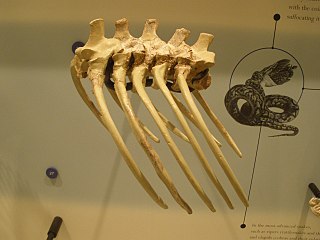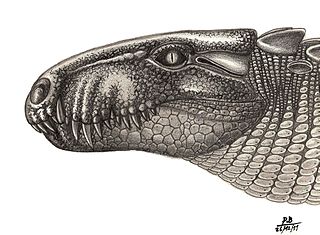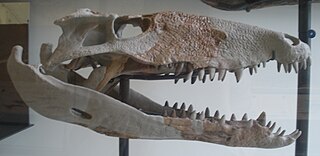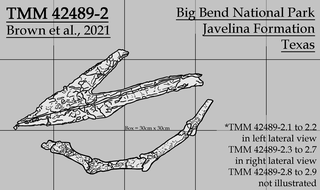Unquillosaurus is a genus of possible maniraptoran or carnosaurian theropod dinosaur from the Late Cretaceous Los Blanquitos Formation of Salta Province, Argentina. The genus contains a single species, U. ceibalii, known only from a single fossilized pubis.

Riojasuchus is an extinct genus of ornithosuchid archosaur from the Late Triassic (Norian) of Argentina. Ornithosuchidae was a widespread family of facultatively bipedal pseudosuchians with adaptations for scavenging. Riojasuchus is notable as one of the youngest and most complete members of the family. The type and only known species, Riojasuchus tenuisceps, was named and described by José Bonaparte in 1967. It was one of the first of many well-preserved Triassic archosaurs to be discovered in Argentina. The holotype specimen, PVL 3827, was found in the Los Colorados Formation of the Ischigualasto-Villa Unión Basin in northwestern Argentina.

Madtsoiidae is an extinct family of mostly Gondwanan snakes with a fossil record extending from early Cenomanian to late Pleistocene strata located in South America, Africa, India, Australia and Southern Europe. Madtsoiidae include very primitive snakes, which like extant boas and pythons would likely dispatch their prey by constriction. Genera include Madtsoia, one of the longest snakes known, at an estimated 10 metres (33 ft), and the Australian Wonambi and Yurlunggur. As a grouping of basal forms the composition and even the validity of Madtsoiidae is in a state of flux as new pertinent finds are described, with more recent evidence suggesting that it is paraphyletic as previously defined.

Madtsoia is an extinct genus of madtsoiid snakes. It is known from the Eocene of Argentina, the Paleocene of Brazil, the Late Cretaceous (Maastrichtian) of India, and the Late Cretaceous (Maastrichtian) of Madagascar. The type species was the largest with an estimated length of 9–10 m (30–33 ft), and the other three species were smaller. A 5.1 m (17 ft) long M. madagascariensis would have weighed 50 kg (110 lb), but an isolated specimen suggests that this species reached 8 m (26 ft) in maximum length.

Palaearctonyx is an extinct genus of omnivorous placental mammals from clade Carnivoraformes, that lived in North America from the early to middle Eocene.

Andrewsornis is an extinct genus of giant flightless predatory birds of the family Phorusrhacidae or "terror birds" that lived in Oligocene Argentina. Fossils have been found in the Sarmiento Formation, and possibly the Agua de la Piedra Formation.

Acroplous is an extinct genus of dvinosaurian Temnospondyli within the family Eobrachyopidae.
Pabwehshi is an extinct genus of mesoeucrocodylian. It is based on GSP-UM 2000, a partial snout and corresponding lower jaw elements, with another snout assigned to it. These specimens were found in Maastrichtian-age Upper Cretaceous rocks of the Vitakri and Pab Formations in Balochistan, Pakistan, and represent the first diagnostic crocodyliform fossils from Cretaceous rocks of South Asia. Pabwehshi had serrated interlocking teeth in its snout that formed a "zig-zag" cutting edge. Pabwehshi was named in 2001 by Jeffrey A. Wilson and colleagues. The type species is P. pakistanensis, in reference to the nation where it was found. It was traditionally classified as a baurusuchid closely related to Cynodontosuchus and Baurusuchus. Larsson and Sues (2007) found close affinity between Pabwehshi and the Peirosauridae within Sebecia. Montefeltro et al.Pabwehshi has a sagittal torus on its maxillary palatal shelves – a character that is absent in baurusuchids – but they did not include Pabwehshi in their phylogenetic analysis.

Brachychampsa is an extinct genus of alligatoroid, possibly a basal caiman. Specimens have been reported from New Mexico, Colorado, Wyoming, Montana, North and South Dakota, New Jersey, and Saskatchewan, though only those from Montana, Utah, and New Mexico are based on material sufficient to justify the referral. One specimen has been reported from the Darbasa Formation of Kazakhstan, although the species status is indeterminate for the fossil. The genus first appeared during the late Campanian stage of the Late Cretaceous and became extinct during the late Maastrichtian stage of the Cretaceous. Brachychampsa is distinguished by an enlarged fifth maxillary tooth in the upper jaw.

Bretesuchus is an extinct genus of sebecosuchian mesoeucrocodylian within the family Sebecidae known from northwestern Argentina. It was a large apex predator.
Triconolestes is an extinct genus of Late Jurassic eutriconodont mammal from the Morrison Formation, present in stratigraphic zones 4. Known from only a single molar, it is a small mammal typically considered an amphilestid. However, it has also been compared to Argentoconodon, which has been considered a volaticothere related to gliding mammals such as Volaticotherium and Ichthyoconodon.

Sebecus is an extinct genus of sebecid crocodylomorph from Eocene of South America. Like other sebecosuchians, it was entirely terrestrial and carnivorous. The genus is currently represented by two species, the type S. icaeorhinus and S. ayrampu. Several other species have been referred to Sebecus, but were later reclassified as their own genera.

Sebecidae is an extinct family of prehistoric terrestrial sebecosuchian crocodylomorphs, known from the Late Cretaceous and Cenozoic of Europe and South America. They were the latest surviving group of non-crocodilian crocodylomorphs.
Lorosuchus is an extinct genus of sebecid mesoeucrocodylian known from the Río Loro Formation in Tucumán Province of northwestern Argentina.

Anisodontosaurus is an extinct genus of trilophosaurid allokotosaur known from the Middle Triassic Moenkopi Formation of Arizona. The type species, A. greeri, was named and described by Samuel Paul Welles in 1947, and its taxonomic placement was largely unknown until the holotype was reassessed in 1998, when it was recovered as a lepidosauromorph or a trilophosaurid. The holotype, a jaw catalogued as UCMP V3922, was discovered in 1940 and was described seven years later. Apart from the type specimen, Anisodontosaurus is known from the referred specimen UCMP 37815, a right ilium.

Wellnhopterus is an azhdarchid pterosaur recovered from the Late Cretaceous Javelina Formation in Texas that was previously identified as a thalassodromine. It consists of a set of upper and lower jaws, as well as some cervical vertebrae and a fragmentary long bone. In July 2021, the jaws were given the genus name "Javelinadactylus", with the type and only species as "J. sagebieli"; however, this article has now been retracted. In a paper published in December 2021, the complete holotype was independently named Wellnhopterus, with the only species being W. brevirostris. As of 2022, this is the formal name of this pterosaur.
Guemesia is a genus of abelisaurid dinosaur from the Late Cretaceous Los Blanquitos Formation of Salta Province, Argentina. The type and only species is Guemesia ochoai, known from a nearly complete braincase. It is one of the smallest abelisaurids currently known.
Transylvanosaurus is an extinct genus of rhabdodontid ornithopod dinosaur from the Late Cretaceous (Maastrichtian) Hateg Basin of Romania. The type species is Transylvanosaurus platycephalus, known from a fragmentary skull.

Pelecanus paranensis is a fossil pelican from the Upper Miocene of the Paraná Formation, in Entre Ríos Province, Argentina. It is the first fossil pelican described from Argentina and the southernmost to be reported from South America.

Ampelognathus is a genus of ornithopod dinosaur from the Late Cretaceous (Cenomanian) Lewisville Formation of Texas. The type species is Ampelognathus coheni.












